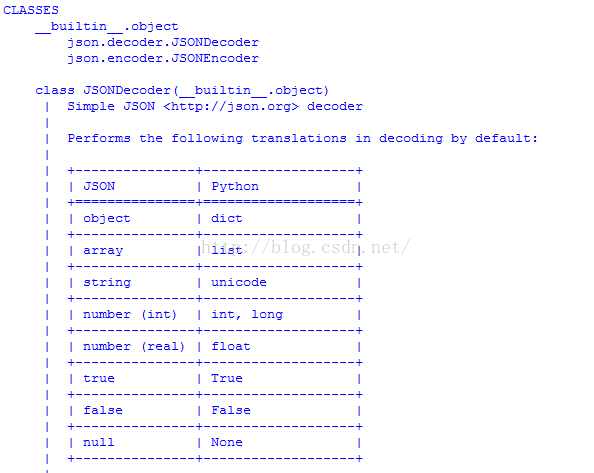Python学习笔记之解析json的方法分析
本文实例讲述了Python解析json的方法。分享给大家供大家参考,具体如下:
刚学习到Python中解析json的方法,觉得有必要在这里坐下笔记。
我是在python的内部环境中看的
Encoding basic Python object hierarchies
>>> import json
>>> json.dumps(['foo', {'bar': ('baz', None, 1.0, 2)}])
'["foo", {"bar": ["baz", null, 1.0, 2]}]'
>>> print json.dumps("\"foo\bar")
"\"foo\bar"
>>> print json.dumps(u'\u1234')
"\u1234"
>>> print json.dumps('\\')
"\\"
>>> print json.dumps({"c": 0, "b": 0, "a": 0}, sort_keys=True)
{"a": 0, "b": 0, "c": 0}
>>> from StringIO import StringIO
>>> io = StringIO()
>>> json.dump(['streaming API'], io)
>>> io.getvalue()
'["streaming API"]'
Compact encoding::
>>> import json
>>> json.dumps([1,2,3,{'4': 5, '6': 7}], sort_keys=True, separators=(',',':'))
'[1,2,3,{"4":5,"6":7}]'
Pretty printing::
>>> import json
>>> print json.dumps({'4': 5, '6': 7}, sort_keys=True,
indent=4, separators=(',', ': '))
{
"4": 5,
"6": 7
}
Decoding JSON::
>>> import json
>>> obj = [u'foo', {u'bar': [u'baz', None, 1.0, 2]}]
>>> json.loads('["foo", {"bar":["baz", null, 1.0, 2]}]') == obj
True
>>> json.loads('"\\"foo\\bar"') == u'"foo\x08ar'
True
>>> from StringIO import StringIO
>>> io = StringIO('["streaming API"]')
>>> json.load(io)[0] == 'streaming API'
True
Specializing JSON object decoding::
>>> import json
>>> def as_complex(dct):
if '__complex__' in dct:
return complex(dct['real'], dct['imag'])
return dct
>>> json.loads('{"__complex__": true, "real": 1, "imag": 2}',
object_hook=as_complex)
(1+2j)
>>> from decimal import Decimal
>>> json.loads('1.1', parse_float=Decimal) == Decimal('1.1')
True
Specializing JSON object encoding::
>>> import json
>>> def encode_complex(obj):
if isinstance(obj, complex):
return [obj.real, obj.imag]
raise TypeError(repr(o) + " is not JSON serializable")
>>> json.dumps(2 + 1j, default=encode_complex)
'[2.0, 1.0]'
>>> json.JSONEncoder(default=encode_complex).encode(2 + 1j)
'[2.0, 1.0]'
>>> ''.join(json.JSONEncoder(default=encode_complex).iterencode(2 + 1j))
'[2.0, 1.0]'


或者也可以去看官方文档,自己能学到东西才是真的!
PS:关于json操作,这里再为大家推荐几款比较实用的json在线工具供大家参考使用:
在线JSON代码检验、检验、美化、格式化工具:
http://tools.jb51.net/code/json
JSON**在线格式化工具:
**http://tools.jb51.net/code/jsonformat
在线XML/JSON互相转换工具:
http://tools.jb51.net/code/xmljson
json**代码在线格式化/美化/压缩/编辑/转换工具:
**http://tools.jb51.net/code/jsoncodeformat
在线json压缩/转义工具:
http://tools.jb51.net/code/json_yasuo_trans
更多Python相关内容感兴趣的读者可查看本站专题:《Python操作json技巧总结》、《Python编码操作技巧总结》、《Python图片操作技巧总结》、《Python数据结构与算法教程》、《Python Socket编程技巧总结》、《Python函数使用技巧总结》、《Python字符串操作技巧汇总》、《Python入门与进阶经典教程》及《Python文件与目录操作技巧汇总》
希望本文所述对大家Python程序设计有所帮助。